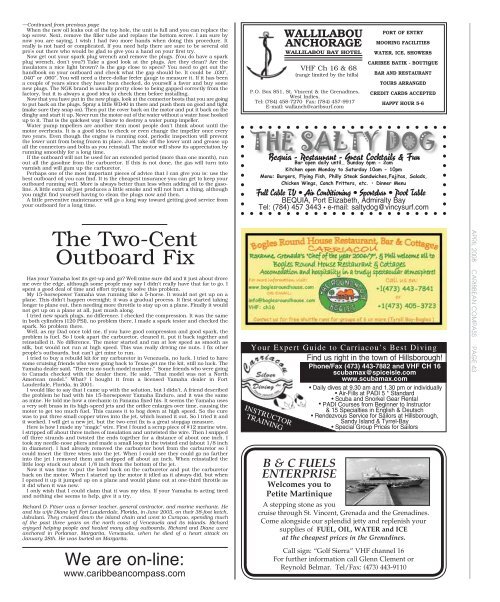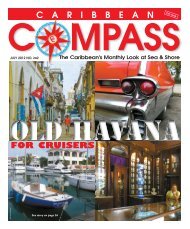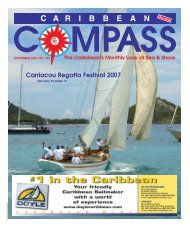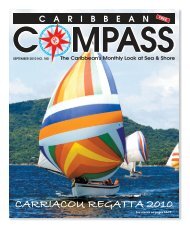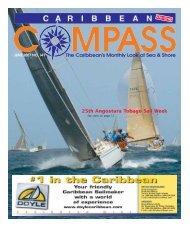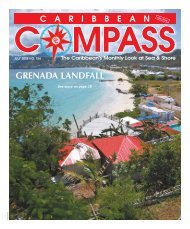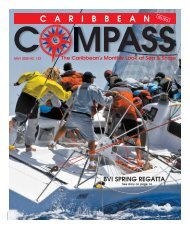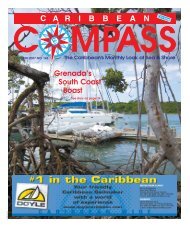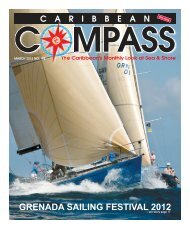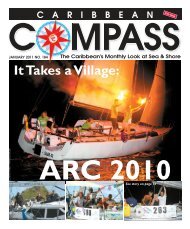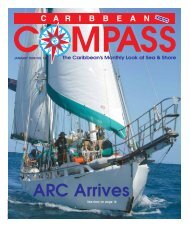Bequia Easter Regatta 2008 - Caribbean Compass
Bequia Easter Regatta 2008 - Caribbean Compass
Bequia Easter Regatta 2008 - Caribbean Compass
Create successful ePaper yourself
Turn your PDF publications into a flip-book with our unique Google optimized e-Paper software.
— Continued from previous page<br />
When the new oil leaks out of the top hole, the unit is full and you can replace the<br />
top screw. Next, remove the filler tube and replace the bottom screw. I am sure by<br />
now you are saying, I wish I had two more hands when doing this procedure. It<br />
really is not hard or complicated. If you need help there are sure to be several old<br />
pro’s out there who would be glad to give you a hand on your first try.<br />
Now get out your spark plug wrench and remove the plugs. (You do have a spark<br />
plug wrench, don’t you?) Take a good look at the plugs. Are they clean? Are the<br />
insulators a nice light brown? Is the gap close to specs? You need to get out the<br />
handbook on your outboard and check what the gap should be. It could be .030”,<br />
.040” or .060”. You will need a three-dollar feeler gauge to measure it. If it has been<br />
a couple of years since they have been checked, do yourself a favor and buy some<br />
new plugs. The NGK brand is usually pretty close to being gapped correctly from the<br />
factory, but it is always a good idea to check them before installing.<br />
Now that you have put in the new plugs, look at the connector boots that you are going<br />
to put back on the plugs. Spray a little WD40 in there and push them on good and tight<br />
(make sure they snap on). Then put the cover back on the motor and put it back on the<br />
dinghy and start it up. Never run the motor out of the water without a water hose hooked<br />
up to it. That is the quickest way I know to destroy a water pump impeller.<br />
Water pump impellers are another item most people don’t think about until the<br />
motor overheats. It is a good idea to check or even change the impeller once every<br />
two years. Even though the engine is running cool, periodic inspection will prevent<br />
the lower unit from being frozen in place. Just take off the lower unit and grease up<br />
all the connectors and bolts as you reinstall. The motor will show its appreciation by<br />
running smoothly for a long time.<br />
If the outboard will not be used for an extended period (more than one month), run<br />
out all the gasoline from the carburetor. If this is not done, the gas will turn into<br />
varnish and will gum up the carburetor.<br />
Perhaps one of the most important pieces of advice that I can give you is: use the<br />
best outboard oil you can find. It is the cheapest insurance you can get to keep your<br />
outboard running well. More is always better than less when adding oil to the gasoline.<br />
A little extra oil just produces a little smoke and will not hurt a thing, although<br />
you might find yourself having to clean the plugs now and then.<br />
A little preventive maintenance will go a long way toward getting good service from<br />
your outboard for a long time.<br />
The Two-Cent<br />
Outboard Fix<br />
Has your Yamaha lost its get-up and go? Well mine sure did and it just about drove<br />
me over the edge, although some people may say I didn’t really have that far to go. I<br />
spent a good deal of time and effort trying to solve this problem.<br />
My 15-horsepower Yamaha was running like a 5-horse. It would not get up on a<br />
plane. This didn’t happen overnight; it was a gradual process. It first started taking<br />
longer to plane out, then needing more throttle to stay up on a plane. Finally it would<br />
not get up on a plane at all, just mush along.<br />
I tried new spark plugs, no difference. I checked the compression. It was the same<br />
in both cylinders (120 PSI), no problem there. I made a spark tester and checked the<br />
spark. No problem there.<br />
Well, as my Dad once told me, if you have good compression and good spark, the<br />
problem is fuel. So I took apart the carburetor, cleaned it, put it back together and<br />
reinstalled it. No difference. The motor started and ran at low speed as smooth as<br />
silk, but would not run at high speed. This was really driving me nuts. I fix other<br />
people’s outboards, but can’t get mine to run.<br />
I tried to buy a rebuild kit for my carburetor in Venezuela, no luck. I tried to have<br />
some cruising friends who were going back to Texas get me the kit, still no luck. The<br />
Yamaha dealer said, “There is no such model number.” Some friends who were going<br />
to Canada checked with the dealer there. He said, “That model was not a North<br />
American model.” What? I bought it from a licensed Yamaha dealer in Fort<br />
Lauderdale, Florida, in 2001.<br />
I would like to say that I came up with the solution, but I didn’t. A friend described<br />
the problem he had with his 15-horsepower Yamaha Enduro, and it was the same<br />
as mine. He told me how a mechanic in Panama fixed his. It seems the Yamaha uses<br />
a very soft brass in its high-speed jets and the orifice enlarges over time, causing the<br />
motor to get too much fuel. This causes it to bog down at high speed. So the cure<br />
was to put three small copper wires into the jet, which leaned it out. So I tried it and<br />
it worked. I will get a new jet, but the two-cent fix is a great stopgap measure.<br />
Here is how I made my “magic” wire. First I found a scrap piece of #12 marine wire.<br />
I stripped off about three inches of insulation and untwisted the wire. Then I snipped<br />
off three strands and twisted the ends together for a distance of about one inch. I<br />
took my needle-nose pliers and made a small loop in the twisted end (about 1/8 inch<br />
in diameter). I had already removed the carburetor bowl from the carburetor so I<br />
could insert the three wires into the jet. When I could see they could go no farther<br />
into the jet I removed them and snipped off about an inch. When reinstalled the<br />
little loop stuck out about 1/8 inch from the bottom of the jet.<br />
Now it was time to put the bowl back on the carburetor and put the carburetor<br />
back on the motor. When I started up the motor it idled as it always did, but when<br />
I opened it up it jumped up on a plane and would plane out at one-third throttle as<br />
it did when it was new.<br />
I only wish that I could claim that it was my idea. If your Yamaha is acting tired<br />
and nothing else seems to help, give it a try.<br />
Richard D. Fitser was a former teacher, general contractor, and marine mechanic. He<br />
and his wife Diane left Fort Lauderdale, Florida, in June 2003, on their 38-foot ketch,<br />
Jabulani. They cruised down the island chain and west to Curaçao, spending much<br />
of the past three years on the north coast of Venezuela and its islands. Richard<br />
enjoyed helping people and healed many ailing outboards. Richard and Diane were<br />
anchored in Porlamar, Margarita, Venezuela, when he died of a heart attack on<br />
January 28th. He was buried on Margarita.<br />
We are on-line:<br />
www.caribbeancompass.com<br />
WALLILABOU<br />
ANCHORAGE<br />
WALLILABOU BAY HOTEL<br />
VHF Ch 16 & 68<br />
(range limited by the hills)...<br />
P.O. Box 851, St. Vincent & the Grenadines,<br />
West Indies.<br />
Tel: (784) 458-7270 Fax: (784) 457-9917<br />
E-mail: wallanch@caribsurf.com<br />
PORT OF ENTRY<br />
MOORING FACILITIES<br />
WATER, ICE, SHOWERS<br />
CARIBEE BATIK - BOUTIQUE<br />
BAR AND RESTAURANT<br />
TOURS ARRANGED<br />
CREDIT CARDS ACCEPTED<br />
HAPPY HOUR 5-6<br />
<strong>Bequia</strong> - Restaurant - Great Cocktails & Fun<br />
Bar open daily until… Sunday 6pm - 2am<br />
Kitchen open Monday to Saturday 10am - 10pm<br />
Menu: Burgers, Flying Fish, Philly Steak Sandwiches,Fajitas, Salads,<br />
Chicken Wings, Conch Fritters, etc. • Dinner Menu<br />
Full Cable TV • Air Conditioning • Sportsbar • Pool Table<br />
BEQUIA, Port Elizabeth, Admiralty Bay<br />
Tel: (784) 457 3443 • e-mail: saltydog@vincysurf.com<br />
Your Expert Guide to Carriacou’s Best Diving<br />
Find us right in the town of Hillsborough!<br />
Phone/Fax (473) 443-7882 and VHF CH 16<br />
scubamax@spiceisle.com<br />
www.scubamax.com<br />
• Daily dives at 9.30 am and 1.30 pm or individually<br />
• Air-Fills at PADI 5 * Standard<br />
• Scuba and Snorkel Gear Rental<br />
INSTRUCTOR<br />
TRAINING<br />
• PADI Courses from Beginner to Instructor<br />
& 15 Specialties in English & Deutsch<br />
• Rendezvous Service for Sailors at Hillsborough,<br />
Sandy Island & Tyrrel-Bay<br />
• Special Group Prices for Sailors<br />
B & C FUELS<br />
ENTERPRISE<br />
Welcomes you to<br />
Petite Martinique<br />
A stepping stone as you<br />
cruise through St. Vincent, Grenada and the Grenadines.<br />
Come alongside our splendid jetty and replenish your<br />
supplies of FUEL, OIL, WATER and ICE<br />
at the cheapest prices in the Grenadines.<br />
Call sign: “Golf Sierra” VHF channel 16<br />
For further information call Glenn Clement or<br />
Reynold Belmar. Tel/Fax: (473) 443-9110<br />
APRIL <strong>2008</strong> CARIBBEAN COMPASS PAGE 43


